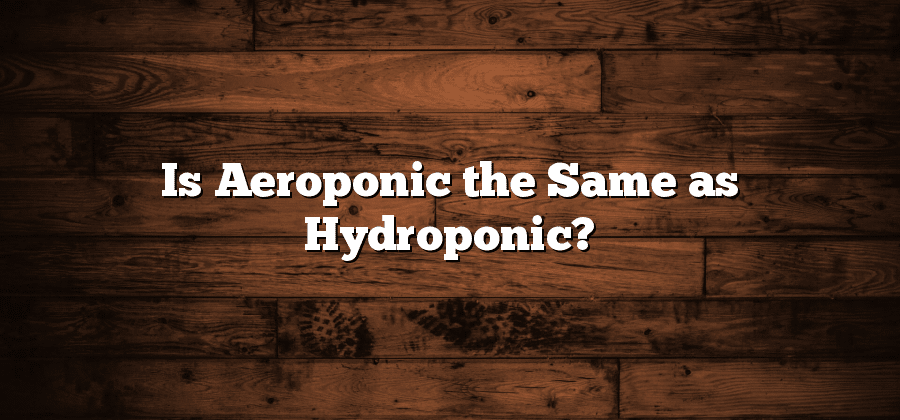Aeroponics: Definition and Explanation
Aeroponics is a modern agricultural technique that involves growing plants in an air or mist environment without the use of soil. This method utilizes a nutrient-rich mist that is sprayed directly onto the plant’s roots. The roots are suspended in the air, allowing them to better absorb the essential nutrients and oxygen they need for growth.
Unlike traditional soil-based farming or even hydroponics, aeroponics offers a more efficient way of delivering nutrients to plants. By misting the roots with a nutrient solution, plants can absorb the necessary elements directly, resulting in quicker growth and higher yields. Additionally, since aeroponics does not require soil, it eliminates the risk of soil-borne pests and diseases, making it a clean and sustainable method of agriculture.
Key Differences Between Aeroponics and Hydroponics
Aeroponics and hydroponics are two popular methods of soilless cultivation, each with its distinct characteristics. One key difference between the two is the way they provide nutrients to plants. In hydroponics, a nutrient-rich solution is directly delivered to the plant roots, while in aeroponics, the plants are suspended in the air, and nutrient misting is used to nourish the roots. This difference in nutrient delivery systems has implications for plant growth and the overall efficiency of the cultivation method.
Another notable difference between aeroponics and hydroponics lies in the root environments they create for the plants. In hydroponics, the roots are typically submerged in the nutrient solution, providing constant access to water and nutrients. On the other hand, aeroponics exposes the roots to intermittent misting, allowing for a more oxygen-rich environment. This oxygenation promotes root growth and nutrient absorption in aeroponic systems. Additionally, the absence of a growing medium in aeroponics reduces the risk of root diseases, making it a favorable choice for those seeking a clean and disease-free cultivation technique.
Advantages of Aeroponics Over Hydroponics
Aeroponics offers several advantages over hydroponics. Firstly, one of the main advantages is the reduced water usage. In aeroponics, plants are misted or sprayed with a fine nutrient solution, which allows for highly efficient water usage. Compared to hydroponics, where plants are grown in a water-based nutrient solution, aeroponics can save up to 90% more water. This is particularly beneficial in areas where water scarcity is a concern or in regions where access to water is limited. Additionally, the reduced water usage in aeroponics results in lower costs associated with water consumption, making it not only environmentally friendly but also economically viable.
Secondly, another advantage of aeroponics is the increased oxygenation of plant roots. In hydroponics, the roots of the plants are submerged in water, which limits the availability of oxygen. In contrast, in aeroponics, the plant roots are suspended in the air, allowing for higher levels of oxygenation. This promotes healthier root growth and enhances nutrient uptake. The increased oxygen levels in aeroponics also contribute to the prevention of harmful pathogens or diseases that thrive in anaerobic conditions. Therefore, aeroponics provides a more favorable root environment for plants, resulting in improved overall plant growth and productivity.
Disadvantages of Aeroponics Compared to Hydroponics
One of the main disadvantages of aeroponics compared to hydroponics is the high technology and expertise required for successful implementation. Aeroponic systems rely heavily on precise misting and nutrient delivery mechanisms, which can be complex and costly to set up and maintain. Additionally, the delicate balance of humidity and temperature needed for optimal root growth in aeroponics can be challenging to achieve and maintain consistently.
Another limitation of aeroponics is its susceptibility to power outages or system failures. Unlike hydroponics, which typically uses a continuously circulating nutrient solution, aeroponics relies on a periodic misting cycle to provide water and nutrients to the roots. If the misting cycle is disrupted for any reason, such as a power outage or malfunctioning equipment, the plants’ roots may dry out and suffer irreversible damage. This dependency on a reliable power source and well-maintained equipment makes aeroponics less suitable for areas with unreliable electricity supply or limited resources for system upkeep.
Aeroponics: How Does It Work?
Aeroponics is a modern agricultural technique that involves growing plants without the need for soil or traditional hydroponic systems. Instead, aeroponic systems utilize a misting or fogging mechanism to deliver a nutrient-rich solution directly to the plant’s roots. This misting process creates a highly oxygenated environment for the roots, facilitating the absorption of nutrients and promoting rapid growth.
In an aeroponic system, the plants are typically housed in a chamber or enclosure above a reservoir that contains the nutrient solution. The roots of the plants are suspended in the air, either by being misted or placed on specially designed platforms. The nutrient solution is delivered to the roots through a series of misters or foggers, which atomize the solution into tiny droplets. These droplets envelop the root system, providing a highly efficient method of nutrient delivery. Additionally, the misting process also helps to maintain optimal humidity levels within the growing environment, further enhancing plant growth.






